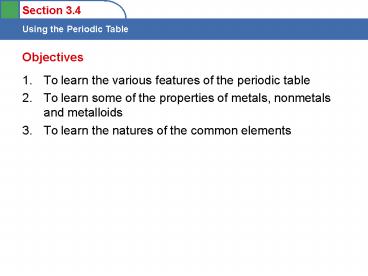Objectives - PowerPoint PPT Presentation
1 / 13
Title:
Objectives
Description:
Objectives To learn the various features of the periodic table To learn some of the properties of metals, nonmetals and metalloids To learn the natures of the common ... – PowerPoint PPT presentation
Number of Views:43
Avg rating:3.0/5.0
Title: Objectives
1
Objectives
- To learn the various features of the periodic
table - To learn some of the properties of metals,
nonmetals and metalloids - To learn the natures of the common elements
2
A. Introduction to the Periodic Table
- The periodic table shows all of the known
elements in order of increasing atomic number.
3
A. Introduction to the Periodic Table
- The periodic table is organized to group elements
with similar properties in vertical columns.
4
A. Introduction to the Periodic Table
- Most elements are metals and occur on the left
side.
- The nonmetals appear on the right side.
- Metalloids are elements that have some metallic
and some nonmetallic properties.
5
A. Introduction to the Periodic Table
- Physical Properties of Metals
- Conduct heat and electricity easily
- Malleable (can be hammered into thin sheets)
- Ductile (can be pulled into wires)
- A lustrous (shiny) appearance
6
B. Natural States of the Elements
- Most elements are very reactive.
- Elements are not generally found in uncombined
form. - Exceptions are
- Noble metals gold, platinum and silver
- Noble gases Group 8
7
A. Electron Arrangements in the First 18 Atoms
on the Periodic Table
Classifying Electrons
- Valence electrons electrons in the outermost
(highest) principal energy level of an atom - Core electrons inner electrons
- Elements with the same number of valence
electrons show very similar chemical behavior.
8
Valence Electrons
- The labels for groups 1, 2, 3, 4, 5, 6, 7, 8
indicate the total number of valence electrons
for the atoms of the elements in these groups - They are called the representative elements
9
B. Electron Configurations and the Periodic Table
- Orbital filling and the periodic table
10
C. Atomic Properties and the Periodic Table
Atomic Size
- Size tends to increase down a column.
- Size tends to decrease across a row.
11
C. Atomic Properties and the Periodic Table
- Ionization Energies
- Ionization Energy energy required to remove an
electron from an individual atom (gas)
- Tends to decrease down a column
- Tends to increase across a row
12
Electronegativity
- Electronegativity the relative ability of an
atom in a molecule to attract shared electrons to
itself - Increases from left to right across a period
- Decreases down a group of representative elements
13
Ionic bonding and Size
- Metallic ions are always smaller than the parent
atom
- Non-metallic ions are always larger than the
parent atom

